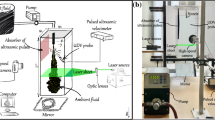Abstract
In this paper, mixing between the fluid from a primary planar jet and two surrounding secondary planar jets which are pulsated out-of-phase is studied experimentally. Solenoid values are used to control the flow injection into the mixing channel with pulse-width modulation. The experiments are conducted using water at a range of pulsation frequency, two duty cycles (25 and 50%) and a mean Reynolds number between 100 and 250. The flow rate ratio between the primary and secondary flow is kept as unity. Both particle-image velocimetry and planar laser-induced fluorescence techniques are used to visualise the flow patterns and to quantify the mixing degree in the mixing channel. This mixing enhancement method is shown to be effective with a mixing degree as high as 0.9 achieved at a mean Reynolds number of about 166. A combination of different mixing mechanisms is found at play, including sequential segmentation, shearing and stretching, vortex entrainment and breakup. At a given Reynolds number, an optimal frequency exists which scales approximately with a Strouhal number (St = fh/U) of unity. Furthermore, at a given mean Reynolds number a lower duty cycle is found to produce a better mixing due to a resultant higher instantaneous Reynolds number in the jet flow.
Graphical Abstract









Similar content being viewed by others
References
Bothe D, Stemich C et al (2006) Fluid mixing in a T-shaped micro-mixer. Chem Eng Sci 61(9):2950–2958
Glasgow I, Aubry N (2003) Enhancement of microfluidic mixing using time pulsing. Lab on a Chip 3(2):114–120
Hessel V, Löwe H et al (2005) Micromixers—review on passive and active mixing principles. Chem Eng Sci 60(8–9):2479–2501
Hoffmann M, Schluter M et al (2006) Experimental investigation of liquid–liquid mixing in T-shaped micro-mixers using -LIF and -PIV. Chem Eng Sci 61(9):2968–2976
Huiqian Y, Nguyen NT et al (2006) Micromixer based on Taylor dispersion. J Phys Conf Ser 34(1):136–141
InvotecSolution (2004) Static SMX mixing elements for mixing/dispersing of viscous fluids. http://www.invotecsolutions.co.uk/web/pdf/stamixco/smx_fluid.pdf
Klaassen GP, Peltier WR (2006) The onset of turbulence in finite-amplitude Kelvin Helmholtz billows. J Fluid Mech Dig Arch 155:1–35
Melton LA, Lipp CW (2003) Criteria for quantitative PLIF experiments using high-power lasers. Exp Fluids 35(4):310–316
Nguyen NT, Wu Z (2005) Micromixers—a review. J Micromech Microeng 15(2):R1–R16
Niu X, Lee YK (2003) Efficient spatial-temporal chaotic mixing in microchannels. J Micromech Microeng 13(3):454–462
Paik P, Pamula VK et al (2003) Rapid droplet mixers for digital microfluidic systems. Lab on a Chip 3(4):253–259
Paul EL, Atiemo-Obeng VA et al (2004) Handbook of industrial mixing: science and practice. Wiley-Interscience, New York
Wong SH, Ward MCL et al (2004) Micro T-mixer as a rapid mixing micromixer. Sens Actuators B Chem 100(3):359–379
Zalc JM, Szalai ES et al (2002) Characterization of flow and mixing in an SMX static mixer. AIChE J 48(3):427–436
Acknowledgments
The first author of this paper, Qingfeng Xia, would like to acknowledge the financial support from both The University of Manchester and The Universities UK for his PhD studies. He also would like to thank Dr Shanying Zhang for his advice on the use of experimental instrumentations.
Author information
Authors and Affiliations
Corresponding author
Rights and permissions
About this article
Cite this article
Xia, Q., Zhong, S. Quantification of liquid mixing enhanced by alternatively pulsed injection in a confined jet configuration. J Vis 15, 57–66 (2012). https://doi.org/10.1007/s12650-011-0103-0
Received:
Revised:
Accepted:
Published:
Issue Date:
DOI: https://doi.org/10.1007/s12650-011-0103-0




